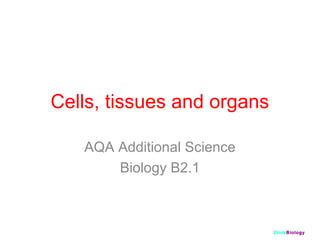
Cells(1)
- 1. ClickBiology Cells, tissues and organs AQA Additional Science Biology B2.1
- 2. ClickBiology BTEOTSSSBAT: • Identify and describe the structure of plant cells and animal cells, and describe the functions of their parts. • Describe the difference between animal cells and plant cells. • Explain the structure and function of specialised cells: red blood cell, muscle cells, ciliated cells, xylem vessels and root hair cells. • Define the terms tissue, organ and organ systems, with examples.
- 3. ClickBiology BTEOTSSSBAT: • Identify and describe the structure of plant cells and animal cells, and describe the functions of their parts. • Describe the difference between animal cells and plant cells. • Explain the structure and function of specialised cells: red blood cell, muscle cells, ciliated cells, xylem vessels and root hair cells. • Define the terms tissue, organ and organ systems, with examples.
- 4. ClickBiology A section through a liver cell (animal cell): cell membrane cytoplasm nucleus DNA controls what enters and leaves the cell metabolic (chemical) reactions occur here contains the DNA and so controls the cell contains the coded instructions to make proteins
- 5. ClickBiology Section through a palisade cell of a leaf (plant cell) cell membrane nucleus cytoplasm chloroplast large sap vacuole cellulose cell wall
- 6. ClickBiology BTEOTSSSBAT: • Identify and describe the structure of plant cells and animal cells, and describe the functions of their parts. • Describe the difference between animal cells and plant cells. • Explain the structure and function of specialised cells: red blood cell, muscle cells, ciliated cells, xylem vessels and root hair cells. • Define the terms tissue, organ and organ systems, with examples.
- 7. ClickBiology Comparing animal and plant cells Found in both animal and plant cells Found only in plant cells cell membrane cellulose cell wall nucleus large sap vacuole cytoplasm chloroplast
- 8. ClickBiology BTEOTSSSBAT: • Identify and describe the structure of plant cells and animal cells, and describe the functions of their parts. • Describe the difference between animal cells and plant cells. • Explain the structure and function of specialised cells: red blood cell, muscle cells, ciliated cells, xylem vessels and root hair cells. • Define the terms tissue, organ and organ systems, with examples.
- 9. ClickBiology Red blood cells transport oxygen cell surface membrane cytoplasm contains no nucleus cytoplasm contains haemoglobin bi-concave disc shape allows more room for haemoglobin increases surface area over which absorption of oxygen can occur haemoglobin is a protein which carries the oxygen molecules
- 10. ClickBiology Muscle cells contract and enable movement of the body nucleus cell surface membrane protein strands The strands of protein slide over each other making the muscle cell (fibre) shorter and causing the muscle to contract Muscle cells have many nuclei muscle
- 11. ClickBiology Ciliated cells move bacteria and dust away from the lungs cilia magnification X3000 nucleus Cilia are small extensions of the cell. They beat rhythmically to sweep mucus, which has trapped bacteria and dust, away from the lungs
- 12. ClickBiology Xylem vessels transport water and minerals up the plant xylem vessel lignin no cytoplasm longitudinal sectioncross-section water-proof and strong; helps support the plant hollow: allows for continuous flow of water and dissolved mineral ions xylem vessels are continuous tubes
- 13. ClickBiology Root hair cells absorb minerals and water from the soil cytoplasm contains no chloroplasts as no photosynthesis is needed root hair increases surface area for absorption of water and mineral ions Cross-section of a root hair cell cell membrane semi-permeable, so will allow water and mineral ions into the cell
- 14. ClickBiology BTEOTSSSBAT: • Identify and describe the structure of plant cells and animal cells, and describe the functions of their parts. • Describe the difference between animal cells and plant cells. • Explain the structure and function of specialised cells: red blood cell, muscle cells, ciliated cells, xylem vessels and root hair cells. • Define the terms tissue, organ and organ systems, with examples.
- 15. ClickBiology A tissue is a group of cells of similar structure that perform a shared function Animal tissues: muscle tissue nervous tissue upper epidermal tissue palisade mesophyll tissue spongy mesophyll tissue lower epidermal tissue Tissues found in the leaf Cross-section of a leaf
- 16. ClickBiology An organ is a structure made of a group of tissues working together to perform specific functions Plant organs include the stem and the leaves heart stomach lungs liver brain kidneys
- 17. ClickBiology An organ system is a group of organs that coordinate to perform related functions In plants the shoot is an organ system consisting of leaves and the stem lymphatic system respiratory system digestive system excretory system reproductive system muscular system skeletal system nervous system endocrine system circulatory system
- 18. ClickBiology Levels of organisation nerve cell nervous tissue brain nervous system Homo sapiens smallest largest cell tissue organ organ systems organism
- 19. ClickBiology Now you should be able to: • Identify and describe the structure of plant cells and animal cells, and describe the functions of their parts. • Describe the difference between animal cells and plant cells. • Explain the structure and function of specialised cells: red blood cell, muscle cells, ciliated cells, xylem vessels and root hair cells. • Define the terms tissue, organ and organ systems, with examples.
- 20. ClickBiology
- 21. ClickBiology
- 22. ClickBiology
Editor's Notes
- Now you should be able to Explain why many animals have a heart and circulation (a mass transport system) And Explain the importance of water as a solvent in transport, including its dipole nature.